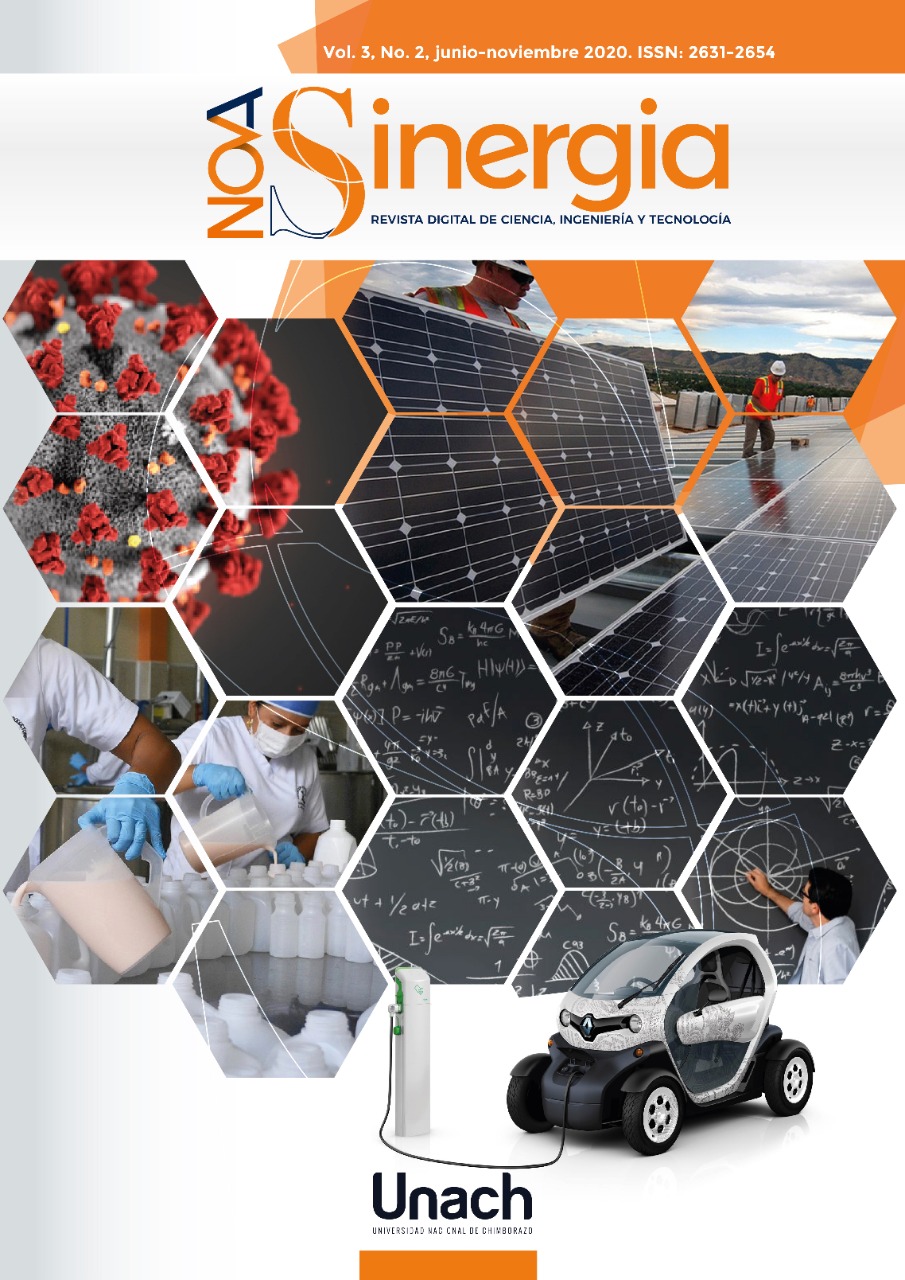Study of the adsorption of Drimaren Yellow CL-2R and Basic Navy Blue 2 RN dyes on activated clays
DOI:
https://doi.org/10.37135/ns.01.06.08Keywords:
Adsorption isotherms, adsorption kinetics, Basic Navy 2 RN, clays, Drimaren Yellow CL-2RAbstract
Clays have become highly engaging non-conventional adsorbents due to their availability, low cost, and high effectiveness adsorbing dye. The objective of this research was to study the adsorption of a cationic dye Drimaren Yellow CL-2R and an anionic dye Basic Navy Blue 2 RN on three clays from Cochancay, Santa Clara, and Shirahuan natural Ecuadorian deposits. Clays were characterized by x-ray fluorescence spectroscopy and x-ray diffraction. The ultraviolet-visible spectroscopy allowed the quantification of the dyes remaining in the solution. We studied the pH, the absorbate's contact time with the adsorbent, initial dye concentration, and clay amount effects. The effectiveness of three clays removing the cationic dye was 95-99%, and the anionic dye was 70%. The Langmuir's isothermal model fits the cationic (R2=0.998), and anionic (R2=0.977) dyes adsorption mechanism. The Shirahuan clay shows a higher cationic dye adsorption capacity (27.53 mg/g). The Cochancay clay shows a higher anionic dye adsorption capacity (5.81 mg/g). The dye adsorption kinetic follows the "pseudo-second-order" model for both dyes and suggests that the adsorption rate is proportional to the available adsorption sites' square. The results suggest that intraparticle diffusion is a major controlling adsorption step. Activated clays show six times greater adsorption capacity removing cationic dye than anionic dye from synthetic water samples.
Downloads
References
Abdeen, Z., & Mohammad, S. G. (2014). Study of the Adsorption Efficiency of an Eco-Friendly Carbohydrate Polymer for Contaminated Aqueous Solution by Organophosphorus Pesticide. Open Journal of Organic Polymer Materials, 4(January), 16–28.
Aid, A., Andrei, R. D., Amokrane, S., Cammarano, C., Nibou, D., & Hulea, V. (2017). Ni-exchanged cationic clays as novel heterogeneous catalysts for selective ethylene oligomerization. Applied Clay Science, 146(June), 432–438.
https://doi.org/10.1016/j.clay.2017.06.034
Ali, L., Alhassani, H., Karuvantevida, N., Rauf, M., & Ashraf, S. (2014). fficient Aerobic Degradation of Various Azo Dyes by a Sphingomonas sp Isolated from Petroleum Sludge. Journal of Bioremediation & Biodegradation, 05(03).
https://doi.org/10.4172/2155-6199.1000223.
Araújo, C. S., Almeida, I. L., Rezende, H. C., Marcionilio, S. M., Léon, J. J., & de Matos, T. N. (2018). Elucidation of mechanism involved in adsorption of Pb (II) onto lobeira fruit (Solanum lycocarpum) using Langmuir, Freundlich and Temkin isotherms. Microchemical Journal, 137, 348-354.
Baban, A., Yediler, A., & Ciliz, N. K. (2010). Integrated water management and CP implementation for wool and textile blend processes. Clean Soil, Air, Water, 38(1), 84-90.
Bergaya, F., & Lagaly, G. (2013). Clays, Clays Minerals, and Clay Science. Handbook of clay science. In Handbook of Clay Science. Second Edición. Elsiver.84-114p.
Budnyak, T. M., Vlasova, N. N., Golovkova, L. P., Slabon, A., & Tertykh, V. A. (2019). Bile acids adsorption by chitoan-fumed silica enterosorbent. Colloid and Interface Science Communications, 32, 100194.
Calvete, T., Lima, E. C., Cardoso, N. F., Dias, S. L. P., & Pavan, F. A. (2009). Application of carbon adsorbents prepared from the Brazilian pine-fruit-shell for the removal of Procion Red MX 3B from aqueous solution-Kinetic, equilibrium, and thermodynamic studies. Chemical Engineering Journal, 155(3), 627–636. https://doi.org/10.1016/j.cej.2009.08.019
Carretero, I., & Pozo, M. (2007). Mineralogía aplicada: Salud y medio ambiente. Madrid, Thompson. pp. 406.
Figueroa, I. (2012). Diagnóstico de las estadísticas del agua en ecuador. CEPAL - Ecuador. Recuperado de: https://docplayer.es/5177693-Diagnostico-de-las-estadisticas-del-agua-en-ecuador-informe-final.html
Dada, A., Olalekan, A., Olantunya, A., & Dada, O. (2012). Langmuir, Freundlich, Temkin and Dubinin–Radushkevich Isotherms Studies of Equilibrium Sorption of Zn2+ Unto Phosphoric Acid Modified Rice Husk. IOSR. Journal of Applied Chemistry, 3(1), 38–45. https://doi.org/10.9790/5736-0313845.
Elmoubarki, R., Mahjoubi, F. Z., Tounsadi, H., Moustadraf, J., Abdennouri, M., Zouhri, A., & Barka, N. (2015). Adsorption of textile dyes on raw and decanted Moroccan clays: Kinetics, equilibrium and thermodynamics. Water Resources and Industry, 9, 16–29. https://doi.org/10.1016/j.wri.2014.11.001
Fassbender, H. W., & Bornemisza, E. (1987). Química de Suelos con enfasis en suelos de América Latina. Colección de Libros y Materiales Educativos N° 81. IICA.
Halbus, A. F., Athab, Z. H., & Hussein, F. H. (2013). Adsorption of disperse blue dye on Iraqi date palm seeds activated carbon. International Journal of Chemical Sciences, 11(3), 1219-1233.
Ho, Y., & Mckay, G. (1999). Pseudo-second order model for sorption processes. Process biochemistry, 34, 451–465.
Kroumov, D. (2014) Determination of the mass transfer-limiting step of dye adsorption onto commercial adsorbent by using mathematical models. Environmental Technology, 3
https://doi.org/10.1016/S0032-9592(98)00112-5
Mahmoodi, N. M., Salehi, R., & Arami, M. (2011). Binary system dye removal from colored textile wastewater using activated carbon: Kinetic and isotherm studies. Desalination, 272(1–3), 187–195.
https://doi.org/10.1016/j.desal.2011.01.023
Pleşa, R., Tănase, A., Bedelean, H., & Măicăneanu, A. (2016). Characterization of Romanian bentonitic clays for the removal of dyes from wastewater. Analytical Letters, 49(16), 2686-2701.
Rahman, A., Urabe, T., & Kishimoto, N. (2013). Color removal of reactive procion dyes by clay adsorbents. Procedia Environmental Sciences, 17, 270–278.
https://doi.org/10.1016/j.proenv.2013.02.038
Saini, J., Garg, V. K., & Gupta, R. K. (2018). Removal of Methylene Blue from aqueous solution by Fe3O4@Ag/SiO2 nanospheres: Synthesis, characterization and adsorption performance. Journal of Molecular Liquids, 250, 413–422.
https://doi.org/10.1016/j.molliq.2017.11.180
Weber, T. W., & Chakravorti, R. K. (1974). Pore and Solid Diffusion Models for Fixed-Bed Adsorbers. AIChe Journal, 20(2), 228–238.
https://doi.org/10.1002/aic.690200204
Weber, W. J., & Morris, J. C. (1963). kinetics of adsorption on carbon from solution. Journal of the Sanitary Engineering Division, 89(2), 31–60.
Zhao, Y., Yang, S., Ding, D., Chen, J., Yang, Y., Lei, Z., ... & Zhang, Z. (2013). Effective adsorption of Cr (VI) from aqueous solution using natural Akadama clay. Journal of Colloid and Interface Science, 395, 198-204







